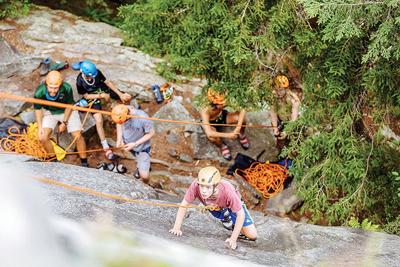Decisions can be scary. Without certainly knowing an outcome, people make choices every day. Some work out, and others provide unforeseen results. Both contribute to developing a healthy process for making decisions. By doing, people learn how it feels to make decisions and how they overcome internal and external factors that impede or help the process. However, decision-making is not a naturally easy process for many. And for children, decisions can be even scarier. After years of making decisions, most adults naturally find their process. However, where can children find more opportunities to independently and collaboratively make decisions safely? Camp.
Do I stay, or do I go?
It starts with the decision about camp. By including them in the process, campers feel empowered and learn how to consider multiple factors in coming to a decision. A camper may have a friend at camp and want to go or a parent might want their child to have a similar experience they did as a kid. Both are valid reasons to go to camp, but there are other to consider before giving the green light. When the process is done together, parents and children are both honing their decision-making tools.
What do I wear? What do I eat? What do I do?
Every summer, campers will address these questions independent of their parents for the first time. A camper may be used to school only. Parents might decide an outfit, the cafeteria decides what’s on the menu and, and teachers gen-erally decide the daily lessons. Camp can offer choices for children that they’re not used normally facing. At sleepaway camp, campers might have more leeway in what they wear. Day camps might allow campers to select their own activi-ties each day, and for some campers, simply deciding between two food choices can be a first. Campers won’t make these decisions in a vacuum. However, by allowing campers to make even the smallest decision on their own, camp builds confidence in the camper’s decision-making abilities and provides learning opportunities for those choices that don’t pan out. All this is done in the safe, friendly confines of camp.
From the decision to go to camp, to trying new activities, and all the other choices involved, camp is a natural environ-ment that fosters decision-making capabilities. Even for many adults, decisions can be hard. Anxiety is real and fear of making the wrong decision can paralyze. But camps can help this. Camps provide children an opportunity to make de-cisions in a safe, healthy environment daily. Just like getting to Carnegie Hall, better decision-making takes time and practice. Both found in abundance at camp.
For more information about camp or tools for selecting a camp, visit www.acanewengland.org or contact the American Camp Association New England.

















(0) comments
Welcome to the discussion.
Log In
Keep it clean. Please avoid obscene, vulgar, lewd, racist or sexual language.
PLEASE TURN OFF YOUR CAPS LOCK.
Don't threaten. Threats of harming another person will not be tolerated.
Be truthful. Don't knowingly lie about anyone or anything.
Be nice. No racism, sexism or any sort of -ism that is degrading to another person.
Be proactive. Use the "Report" link on each comment to let us know of abusive posts.
Share with us. We'd love to hear eyewitness accounts, the history behind an article.